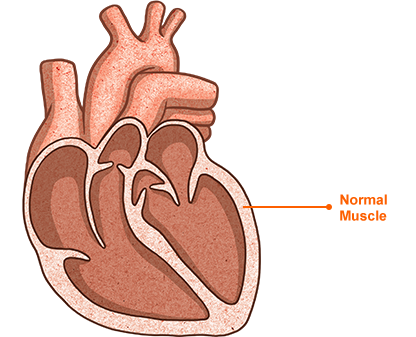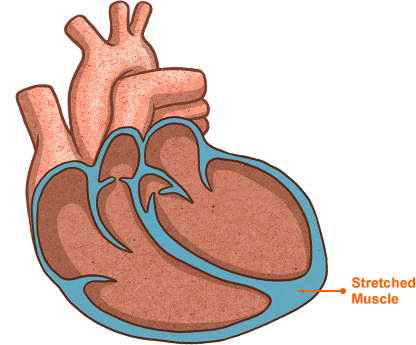
Normal Heart
Strong muscular walls squeeze and relax to pump blood out to all the organs and other parts of the body.

Heart Failure with reduced ejection fraction HFrEF
The heart muscle becomes overstretched and too weak to pump blood properly. About 50% of patients with Heart Failure have HFrEF.
Most common symptoms
Swipe to view more

Shortness of breath with everyday activities
The heart can’t pump enough to keep up with the blood supply. This causes fluid to back up and leak into the lungs.
More 
Shortness of breath with everyday activities
The heart can’t pump enough to keep up with the blood supply. This causes fluid to back up and leak into the lungs.
Swelling in legs, feet, and ankles
Fluid backs up and collects in the tissues. The heart isn’t able to pump strongly enough to manage its workload.
More 
Swelling in legs, feet, and ankles
Fluid backs up and collects in the tissues. The heart isn’t able to pump strongly enough to manage its workload.
A dry, hacking cough that doesn’t go away
The cough is caused by fluid backing up and leaking into the lungs. That’s because the heart can’t keep up with pumping the blood to the rest of the body.
More 
A dry, hacking cough that doesn’t go away
The cough is caused by fluid backing up and leaking into the lungs. That’s because the heart can’t keep up with pumping the blood to the rest of the body.
Trouble sleeping when you lie flat
Fluid backs up into the lungs because the heart can’t keep up with the blood supply.
More 
Trouble sleeping when you lie flat
Fluid backs up into the lungs because the heart can’t keep up with the blood supply.
Rapid weight gain
The heart can’t keep up with the incoming blood supply, so fluid backs up and collects in the tissue.
(3 or more pounds in a day)
More 
Rapid weight gain
The heart can’t keep up with the incoming blood supply, so fluid backs up and collects in the tissue.
(3 or more pounds in a day)
Feeling tired
The limited blood supply is sent away from arm and leg muscles to supply the body’s main organs, like the heart and brain.
More 
Feeling tired
The limited blood supply is sent away from arm and leg muscles to supply the body’s main organs, like the heart and brain.
Both types of Heart Failure share the same symptoms. Learn the differences.
Hear a real patient’s story
Learn how Freddie discovered her HFrEF and what she does to stay on top of it.
Both types of Heart Failure share the same symptoms. Learn the differences.
Hear a real patient’s story
Learn how Freddie discovered her HFrEF and what she does to stay on top of it.
Diagnosing HFrEF
HFrEF is most commonly detected with an ECG, or echocardiogram.
If your ejection fraction is less than or equal to
40%
you have reduced ejection fraction.
That means your heart muscle is weak and is losing its ability to pump out the amount of blood your body needs.
If your ejection fraction is less than or equal to
40%
you have reduced ejection fraction.
That means your heart muscle is weak and is losing its ability to pump out the amount of blood your body needs.
What it may take to diagnose:
Your doctor may suggest one or more of these tests to measure your ejection fraction:
-
Echocardiogram (ECG)—the most widely used test
-
MUGA scan
-
CAT scan
-
Cardiac catheterization
-
Nuclear stress test





